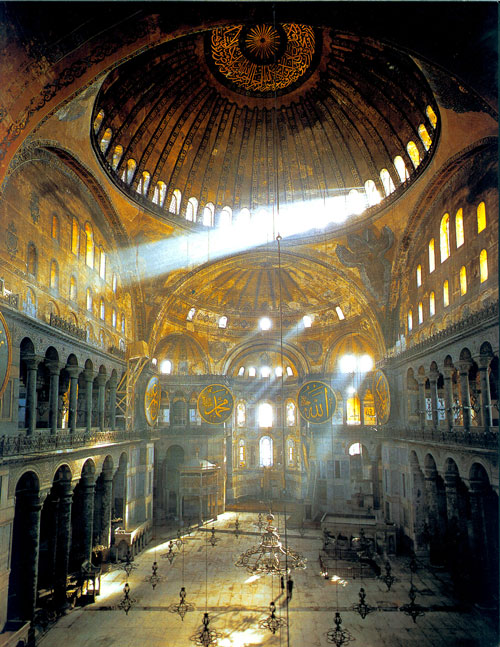In my senior year of high school I was out shopping with my
mom and I pulled a jacket off the rack and as my mother looked at it she said, “I
had one just like that when I was in High school.” Revolted, I put the jacket
back. All the styles that were popular when my mom was in High school and
college are now back in style with a bit of an “eco-friendly” modern twist. Clothing is in style, than two years later you
think back and ask “what was I wearing?!” and this cycle keeps on going around
and around. Then eventually we use same ideas over again but slightly changed. We also
do this in design, as we started with the foundations and then as time
progressed people rejected the old ideas adopted the new ones and then returned
to the “old style” with some elements of the “new style”, thus making a whole
new style. Then that reverberations cycle keeps going.

 The first week of this unit we talked about the music in
church spaces. Which were just developing from the basilica to the first stages
of the church, with the high ceiling and high windows to let the most sunlight
in. Also the expression of stories on colored glass and the building being made
of stone. Now music was present in this
space, like Hagia Sophia and in other worship spaces around the known world. We
talked about the rhythm and balance of poems and music and related that back to
design. Then we moved in the “dark ages” or the medieval time period. Huge
churches that were the early cathedrals were built all over France and England.
The first week of this unit we talked about the music in
church spaces. Which were just developing from the basilica to the first stages
of the church, with the high ceiling and high windows to let the most sunlight
in. Also the expression of stories on colored glass and the building being made
of stone. Now music was present in this
space, like Hagia Sophia and in other worship spaces around the known world. We
talked about the rhythm and balance of poems and music and related that back to
design. Then we moved in the “dark ages” or the medieval time period. Huge
churches that were the early cathedrals were built all over France and England.
Then as the cycle goes people stopped using the Gothic style
and move on to the new change the enlightenment. Where more spaces changed to
places where people would share idea and bring about the reform.
People began to write rules down and we began to build on
what we saw and understood but also so we can help the feature understand what
was being designed during that time, which led to the Rule books.
The western Rule book of design: 1. Revive the past using
the classical language, 2. Strive for harmony and order in all things, 3. Layer
groves and stacks whenever possible. 4 emphasize surface thorough material.5.
Follow the rules 6. Place man at the center 7. Strive for position through patronage.
8. Move towards the secular 9. Get some perspective and 10 expand your physical
world.
But at the same time in the east they were making their own
rule book. 1. Maintain continuity w/ the past 2. Strive for harmony in all
things. 3. Continuing the laying of groves and stacks. 4. Surface and Materiality
5, Follow the Rules 6. Place community before self. 7. Strive for position through
patronage. 8. Embrace spiritual just not religious 9. Sustain systems for
representations and 10. Expand you inner world.
Then almost immediately after these rules are made then
people begin to break them. Bending the rules, breaking some like making wavy
stare cases but still have different materials in sections. Though this is all happening the West, the East does not change their style at all.
In western world design changes again, when the world
expands to now include the American colonies. The style becomes extremely simple
and buildings are made out of all wood and no stone at first. Like the Parson
Capen house.
America is forming we
are copying many buildings from Europe and England. For example the states were making their
state capitol buildings look Greek but the National government was vary Roman, making
the Federalist style. Then as industry is
invented the design world changes again drastically. They begin to use glass in
excess and make buildings taller and stronger. People being to have green
houses at their homes, windows got much bigger and this led to many designs for
the world fairs that start the next unit.
 This whole unit is about how the ideas founded in the first
unit are recycled and then recycled again. As we were connected to the whole
world in the first unit we are still connected to the whole world at the end of
this unit but not through the whole unit. This is just shows that we all
interact with the whole world and then step back and then go back to
interacting again, just like ripples on a pond.
This whole unit is about how the ideas founded in the first
unit are recycled and then recycled again. As we were connected to the whole
world in the first unit we are still connected to the whole world at the end of
this unit but not through the whole unit. This is just shows that we all
interact with the whole world and then step back and then go back to
interacting again, just like ripples on a pond.
Hagia Sophia: http://www.teslasociety.com/pictures/Roman%20Empire%20Images/RomanEmpire2.jpg
church: https://blogger.googleusercontent.com/img/b/R29vZ2xl/AVvXsEjNrLI5Z4hxaQF2oQf_2GfOzuUnqv6Vi5mPa0U6NyjgWS5lGE70ND9Uxn1NcxPMXUbFqXJIvzauEy0_IiQxCsQHWwzSXNg-EVvq2J8NuevGZAV8ZjRJAg9-6Da9iod3E3j6Je3FcoFhdFhH/s1600/402990794_ddbaa43e45.jpg
Last picture: http://www.dougdemercurio.com/wp-content/uploads/2010/09/ripples-in-pond.jpg

beautifully written....and the personal account as an opener sets the whole thing out. well done!!
ReplyDelete